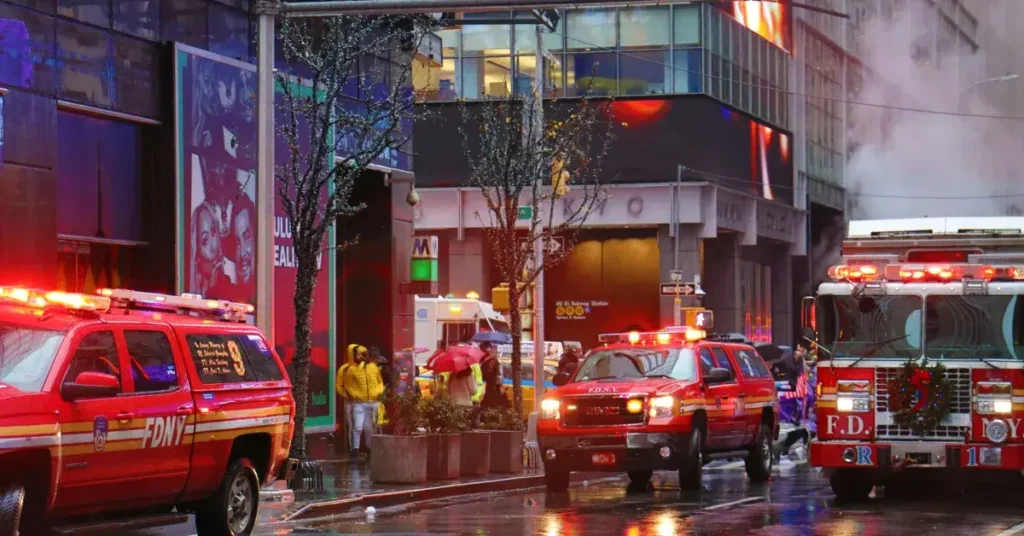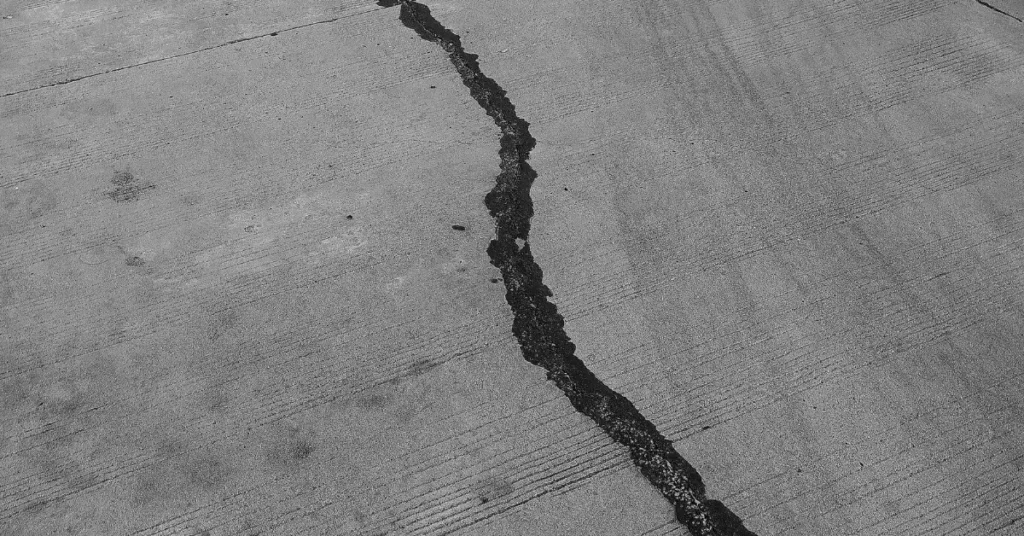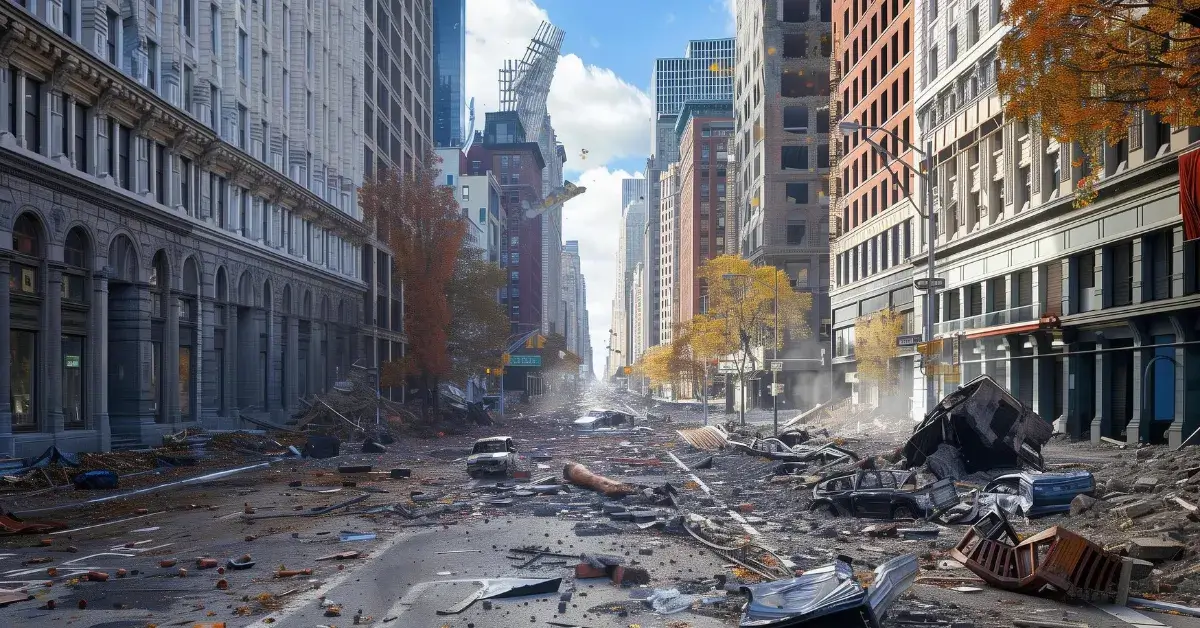In the heart of the United States, New York City stands as a beacon of architectural marvels and a hub of ceaseless activity. Amidst its towering skyscrapers and fast-paced life, the occurrence of earthquakes in New York City presents an intriguing juxtaposition to its urban landscape.
While the seismic activities of the West Coast, particularly California, often dominate headlines, Earthquake New York City reminds us that the East Coast is not immune to the earth’s trembles. This revelation may surprise many, considering the metropolitan’s facade of invulnerability.
The very thought of an Earthquake New York City, with tremors rippling beneath landmarks such as the Statue of Liberty and the Empire State Building, stirs a sense of unease among both locals and tourists. The city’s buildings and infrastructure, mostly not designed with earthquakes in mind, highlight the potential risks involved.
Despite this, historical records and research indicate that Earthquake New York City is not an unheard of phenomenon. The area has felt mild tremors from time to time, with the state witnessing more significant seismic activities on occasion. Monitoring and understanding these natural occurrences are vital for enhancing the city’s preparedness and response mechanisms.
Although Earthquake New York City events of severe magnitude are rare, the implications for such a densely populated metropolis cannot be overlooked. It necessitates vigilant observation and continuous study by seismologists and emergency management professionals to mitigate risks and safeguard the city’s future.
Understanding Earthquakes
When discussing earthquakes in New York City, it’s essential to understand the why and how of their occurrence, their measurement, and the city’s seismic history. These factors together provide a comprehensive picture of New York’s earthquake dynamics.
Causes and Mechanics
Earthquakes result from the sudden release of energy in the Earth’s crust that creates seismic waves, typically due to tectonic movements.
In the northeast of the United States, despite being far from the active plate boundaries of the West Coast, the region is not immune to seismic activity. New York City has experienced small earthquakes within this context, though their mechanics often differ from those in more seismically active regions.
Measuring Magnitude and Intensity
The magnitude of an earthquake describes the energy release, quantified on the Richter scale, now often measured by the moment magnitude scale.
The intensity of shaking varies based on location, depth underground, and local geological conditions. The United States Geological Survey (USGS) plays a pivotal role in monitoring and reporting earthquakes, providing key data that inform research and preparedness efforts.
Historical Earthquake New York City
Historical records indicate that New York City is not a stranger to earthquakes. A notable event occurred, shaking the city without causing significant damage.
Such instances underscore the reality of small earthquakes in the area and the potential for their recurrence. Furthermore, aftershocks, smaller tremors following the initial quake, can occur, compounding the effects of the initial seismic event.
Risk Assessment
The safety of New York’s residents is continually under evaluation through detailed risk assessments related to earthquakes. Understanding the potential impact of seismic activity on this populous city is crucial for preparedness and response planning.
Seismic Activity and Zones

Seismic activity in New York is a reality, with several notable faults such as the 125th Street Fault running through Manhattan and into other boroughs like the Bronx and Westchester.
While not as active as the West Coast’s, New York’s faults still pose a significant threat because of the larger population and infrastructure density.
Building Codes and Infrastructures
Strict building codes in New York City are designed to mitigate the damage from potential earthquakes.
Existing buildings, particularly in older areas like Brooklyn and Queens, may not have been constructed to withstand seismic events and are a focus for risk mitigation strategies.
Probability of Future Earthquakes
Earthquake likelihood in New York is moderate, but even small tremors can cause considerable damage due to the area’s high urbanization.
The United States Geological Survey provides earthquake information, which is essential for assessing the probability of future earthquakes and guiding the city’s preparedness measures. This data not only informs the general public but also aids in refining the city’s hazard mitigation plans.
Impact on New York City
In the unforeseen event of an earthquake in New York City, the ramifications can range from structural damages to critical disruptions in daily life.
Assessing potential damage scenarios, preparing emergency services and response teams, and bolstering public awareness and preparedness form an integral triad of the city’s resilience plan.
Potential Damage Scenarios
New York City’s infrastructure faces numerous risks in the event of an earthquake.
Predictions indicate that Astoria and Roosevelt Island could experience notable structural damage due to their proximity to potential epicenters.
Power outages and compromised utility services could be widespread, severely impacting transit systems and leading to fire hazards.
Emergency Services and Response
Local officials and the Office of Emergency Management are primed to coordinate swift responses.
Specially trained units within the Fire Department and Consolidated Edison (Con Edison) are ready to tackle ensuing fires and restore essential services, respectively.
Their prompt actions are crucial in minimizing injuries and facilitating the recovery process.

Public Awareness and Preparedness
Efforts to elevate public awareness through drills and information campaigns are vital.
Citizens are educated on the importance of emergency kits and evacuation plans.
Moreover, technologies for early warning systems are explored to give the populous a crucial lead time, although predicting the precise occurrence of an earthquake remains a challenge.
Response and Recovery
When the ground shakes in New York City, the response and recovery operations become crucial to mitigate the impact of such events on the bustling East Coast hub.
Dispatching teams, assessing damages, and restoring the rhythm of the metropolis are immediate priorities where agencies like the USGS and the Office of Emergency Management become central.
Disaster Relief Operations
Immediately following an earthquake, disaster relief operations are mobilized.
The Office of Emergency Management coordinates with various agencies to assess structural damages and initiate search and rescue missions.
Essential services focus on providing care for the injured and ensuring public safety amid potential aftershocks.
Infrastructure Restoration
Restoring infrastructure is imperative to facilitate a swift return to normalcy.
Experts from the USGS and local authorities inspect bridges, roads, and buildings for safety and integrity.
Following this, key efforts are organized to prioritize repairing damages to critical facilities like hospitals, fire stations, and power plants, which may have been compromised and could lead to fire hazards if not addressed immediately.
Community Support and Rebuilding
The spirit of New York is reflected in its response to crises: community support and rebuilding efforts begin almost instantaneously.
Collaboration among neighborhood groups, non-profits, and governmental bodies aims to rebuild not just the physical structures, but the lives of those affected through psychological support, temporary housing, and financial aid.

Preventive Measures
Earthquake preparedness in New York City is crucial, given its notoriety as a bustling metropolis not commonly associated with seismic activity.
However, implementing effective preventive measures can significantly mitigate the risks. These strategies are multifaceted, involving rigorous structural engineering, community-wide alert systems, and comprehensive public policies.
Seismic Retrofitting and Engineering
Buildings in New York City can be made safer with seismic retrofitting—a process experts recommend to enhance the earthquake resistance of structures.
The Office of Emergency Management collaborates with structural engineers to ensure new constructions adhere to stringent building codes and older buildings are suitably upgraded.
Early Warning Systems and Drills
Early Warning Systems have been a focal point for local officials, aiming to detect earthquakes before they strike. Pairing these systems with regular drills helps prepare residents and businesses for quick, coordinated action during an event.
Public Policies for Earthquake Mitigation
Local government agencies devise public policies focused on earthquake mitigation.
These policies are grounded in extensive research and advice from experts, incorporating risk assessments and resilience planning to shield the city’s infrastructure and its inhabitants from potential earthquake damage.
Economic and Social Implications
When imagining an earthquake hitting New York City, it’s not just the ground that shakes — the ramifications reverberate through the economy and society.
The prospect of such an event in areas like Manhattan, Queens, Brooklyn, The Bronx, New Jersey, Westchester, and Pennsylvania necessitates a close examination of the potential aftermath.
Cost of Earthquake Damage
Damage costs from a hypothetical earthquake in New York City could escalate into billions of dollars.
The economic impacts stem from direct structural harm to residential and commercial buildings, with New York City’s real estate being particularly vulnerable.
The indirect costs arise from interruptions to business operations and the need for extensive infrastructure repairs.
For instance, the loss estimation for the New York City Metropolitan Region suggests staggering monetary losses.
Impact on Insurance and Real Estate
Following an earthquake, the insurance industry could face an onslaught of claims, substantially increasing premiums.
Real estate values in the areas affected may also suffer, as the demand for housing and office space in earthquake-prone areas declines.
Prospective buyers in neighborhoods such as Manhattan could become wary, potentially redirecting the flow of real estate investments to perceived safer zones.
Implications for Urban Planning
Urban planning would confront a paradigm shift post-earthquake, with a renewed focus on earthquake-resistant construction and retrofitting older buildings.
Zoning laws might evolve, reflecting the necessity to reduce population density in vulnerable areas.
Entities involved in urban planning might utilize insights from the Social Consequences of Disasters to rebuild and develop communities that are more resilient to future seismic shocks.

Geographical Context
New York City’s earthquake activity often catches residents by surprise, given its contrast to the more tremor-prone West Coast. This section explores how seismic events in New York City differ from those in California and what can be learned from other regions.
Comparing East Coast and West Coast Earthquakes
While California is synonymous with earthquakes due to its location along the San Andreas Fault, the East Coast, and specifically New York City, experiences less frequent seismic activity.
This is attributed to the distance from the edge of the North American tectonic plate.
Earthquakes in New York City, although rarer, can be felt over a larger area compared to the West Coast. For instance, tremors from a moderate quake can travel a long distance on the East Coast due to the type of bedrock.
Lessons from Other Regions
Studying seismic activities from various regions, including small explosions in mining operations, provides critical insights for New York City.
Although fewer in number, New York has experienced tremors, such as the one recorded in Astoria, Queens, that serve as reminders of the city’s vulnerability. Learning from regions with similar geological characteristics helps prepare for potential future events.
Transportation and Infrastructure Effects
In the wake of an earthquake, New York City’s transportation infrastructure, including the integrity of bridges, tunnels, and the public transit system, is susceptible to severe disruption.
These structural stresses and potential service interruptions have far-reaching implications for traffic and daily commuting.
Stress on Bridges and Tunnels
New York City bridges and tunnels, vital connectors to boroughs such as Brooklyn and Manhattan, are likely to suffer damage in the event of significant seismic activity.
Inspections may reveal structural compromises that necessitate immediate repair, leading to partial or full closures.
Public Transit System Resilience
The resilience of the public transit system, a lifeline for the city, is put to the test following an earthquake.
Subway lines, particularly those in areas like Astoria, could face shutdowns or rerouting if tracks or stations sustain damage.
Moreover, Amtrak services may be halted or delayed, affecting regional connectivity.
Traffic and Commuting Disruptions
Earthquake aftermath often results in heightened traffic congestion as commuters turn to personal vehicles in response to compromised public transit.
This shift can cause gridlock, especially in high-density regions of Manhattan, complicating emergency responses and recovery efforts.
Frequently Asked Questions
When it comes to seismic activity, residents often inquire about the possibility and history of earthquakes shaking the grounds of New York City. The information provided here addresses the most common concerns regarding this phenomenon.
What is the history of earthquakes in New York City?
New York City’s earthquake history is not as active as the West Coast, but the region has experienced several small to moderate tremors over the years.
Seismic activity is less frequent here but not unheard of.
How significant was the earthquake in New York City on August 23, 2011?
The 2011 earthquake centered in Virginia was felt in New York City, registering a magnitude of 5.8.
While significant, it caused no major damage in the city, but it was a jarring reminder that earthquakes can affect the area.
Can New York City experience a major earthquake?
While the likelihood is lower compared to areas along major fault lines, New York City still has the potential to experience a major earthquake due to its proximity to several older geological structures capable of producing significant seismic events.
Are there any fault lines near New York City that could cause earthquakes?
Indeed, New York City is near several fault lines, including the Ramapo Fault system, which has the potential to generate earthquakes that could impact the city.
What was the magnitude of the largest earthquake recorded in New York City?
The largest earthquake recognized in the New York City area happened centuries ago and is estimated to have been around magnitude 5.0, which is considered moderate in terms of earthquake magnitudes.
How prepared is New York City for a potential earthquake?
New York City has been updating building codes and conducting emergency preparedness drills. They are also taking steps to reinforce infrastructure to withstand potential earthquakes. However, due to the region’s low-to-moderate seismic risk, preparations might not be as robust as in high-risk areas.
If you want to know something about potential Threads in the City check out our Post about Snakes in New York. If you liked that Post and maybe experienced an earthquake by yourself, let us know in the Comments.





